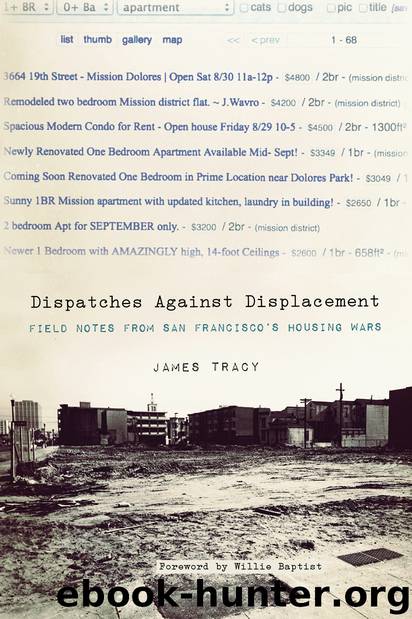Dispatches Against Displacement by Tracy James;

Author:Tracy, James;
Language: ara
Format: epub
Publisher: AK Press
Published: 2014-09-07T04:00:00+00:00
Chapter Four
A Shift toward Stewardship:
Is the Displacement War Over, If We Want It to Be?
2001. The San Francisco Community Land Trust was founded on a basic question: what if we could win the housing war?
San Francisco had seen skilled organizing to defeat evictions, only to have new evictions filed in the same buildings a few years later. Housing occupations rarely had the lasting impact of the actions that forced the Housing Authority to open 250 vacant units. State law curtailed the potential power of rent control. If housing remained in the market, then it would eventually be lost to the market.
A community land trust (CLT) is a form of social housing in which the residents cooperatively own their building but are sewn into a larger community-controlled organization, which owns the land below. Through resale restrictions and ongoing resident education, homes are affordable forever. The land trust helps residents develop the skills of self-management and participatory governance. This arrangement not only protects the interests of residents, but also those of the larger community of people who need housing.
As defined by land trust pioneer John Emmeus Davis, a land trust is distinct from other forms of social ownership in four major ways:
• Land is treated as a common heritage, not as an individual possession. Title to multiple parcels is held by a single not-for-profit, which manages these lands on behalf of a particular community, present and future.
• Land is removed permanently from the market, never resold. Land is put to use, however, by leasing out individual parcels for the construction of housing, the production of food, the development of commercial enterprises, or the promotion of other activities that support individual livelihood or community life.
• All structural improvements are owned separately from the land, with title to these buildings held by individual homeowners, business owners, housing cooperatives, or the owners of any other buildings located on leased land.
• A ground lease lasting many [usually ninety-nine] years gives owners of these structural improvements the exclusive use of land beneath their buildings, securing their individual interests while protecting the interests of the larger community.1
Download
This site does not store any files on its server. We only index and link to content provided by other sites. Please contact the content providers to delete copyright contents if any and email us, we'll remove relevant links or contents immediately.
| Anthropology | Archaeology |
| Philosophy | Politics & Government |
| Social Sciences | Sociology |
| Women's Studies |
Nudge - Improving Decisions about Health, Wealth, and Happiness by Thaler Sunstein(7242)
iGen by Jean M. Twenge(5162)
The Fire Next Time by James Baldwin(5016)
Adulting by Kelly Williams Brown(4234)
The Hacking of the American Mind by Robert H. Lustig(4085)
The Sports Rules Book by Human Kinetics(4078)
The Ethical Slut by Janet W. Hardy(4040)
Captivate by Vanessa Van Edwards(3725)
Mummy Knew by Lisa James(3521)
In a Sunburned Country by Bill Bryson(3367)
The Worm at the Core by Sheldon Solomon(3325)
Ants Among Elephants by Sujatha Gidla(3279)
Suicide: A Study in Sociology by Emile Durkheim(2904)
The Slow Fix: Solve Problems, Work Smarter, and Live Better In a World Addicted to Speed by Carl Honore(2837)
The 48 laws of power by Robert Greene & Joost Elffers(2805)
Humans of New York by Brandon Stanton(2687)
Handbook of Forensic Sociology and Psychology by Stephen J. Morewitz & Mark L. Goldstein(2603)
The Happy Hooker by Xaviera Hollander(2584)
The Tipping Point by Malcolm Gladwell(2559)
